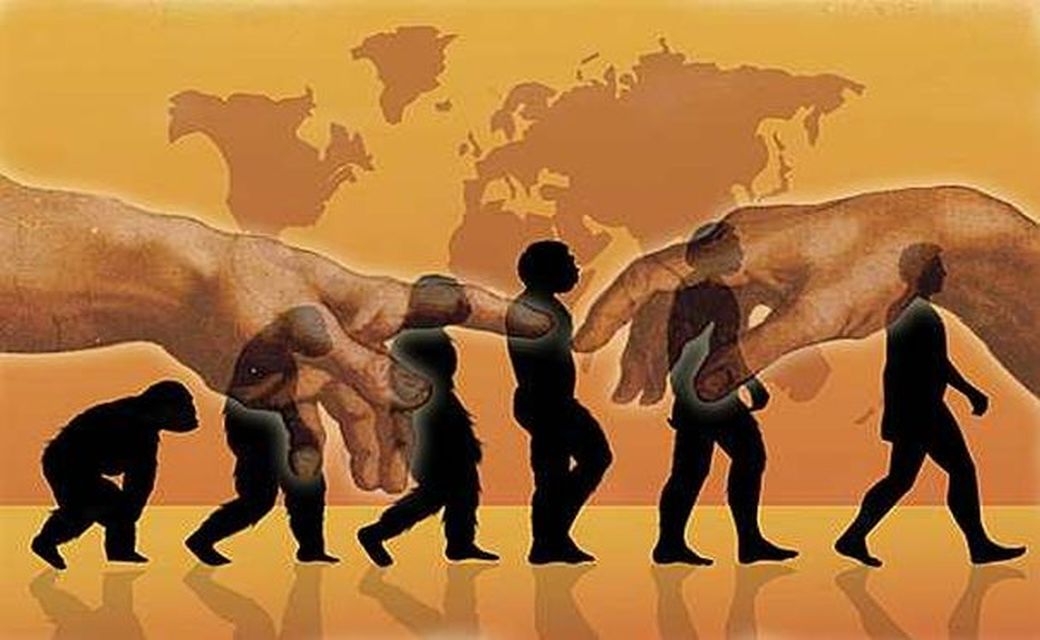This article appeared in the Ask Hank column of the CHRISTIAN RESEARCH JOURNAL, volume 44, number 04 (2021). A older version previously appeared in volume 34, number 1 (2011). For further information or to subscribe to the Christian Research Journal please click here.
“God made the wild animals according to their kinds, the livestock according to their kinds, and all the creatures that move along the ground according to their kinds. And God saw that it was good. Then God said, ‘Let us make man in our image, in our likeness, and let them rule over the fish of the sea and the birds of the air, over the livestock, over all the earth, and over all the creatures that move along the ground.’ So God created man in his own image, in the image of God he created him; male and female he created them.”
—Genesis 1:25–27 NIV1984
Did Humans Evolve from Hominids?
In the television premiere of Ape Man: The Story of Human Evolution, the late CBS Evening News anchor Walter Cronkite declared that monkeys were his “newfound cousins.” Cronkite went on to say: “If you go back far enough, we and the chimps share a common ancestor. My father’s father’s father’s father, going back maybe a half million generations — about five million years — was an ape.”1 Was Cronkite right? Do we and the chimps share a common ancestor? Or is this an illustration of the antiknowledge surrounding ape-men?
First, whether in Ape Man, National Geographic, or Time, the ape-to-man icon has itself become the argument. Put another way, the illustration of a knuckle-dragging ape evolving through a series of imaginary transitional forms into modern man has appeared so many times in so many places that the picture has evolved into the proof. In light of the fanfare attending the most recent candidates nominated by evolutionists to flesh out the icons of evolution, we would do well to remember that past candidates such as Lucy2 have bestowed fame on their finders but have done little to distinguish themselves as prime exemplars of human evolution.
Furthermore, as the corpus of hominid fossil specimens continues to grow, it has become increasingly evident that there is an unbridgeable chasm between hominids and humans in both composition and culture. Moreover, homologous structures (similar structures on different species) do not provide sufficient proof of genealogical relationships — common descent is simply an evolutionary assumption used to explain the similarities. To assume that hominids and humans are closely related because both can walk upright is tantamount to saying hummingbirds and helicopters are closely related because both can fly. Indeed, the distance between an ape, who cannot read or write, and a descendant of Adam, who can compose a musical masterpiece or send a man to the moon, is the distance of infinity.
Finally, evolution cannot satisfactorily account for the genesis of life, the genetic code, or the ingenious synchronization process needed to produce life from a single fertilized human egg. Nor can evolution satisfactorily explain how physical processes can produce metaphysical realities such as consciousness and spirituality. The insatiable drive to produce a “missing link” has substituted selling, sensationalism, and subjectivism for solid science. William Fix said it best: “When it comes to finding a new trooper to star as our animal ancestor, there’s no business like bone business.”3
Did God Use Darwinian Evolution to Create Living Things?
Under the banner of “theistic evolution,” a growing number of Christians maintain that God used evolution as His method for creation. This, in my estimation, is the worst of all possibilities. It is one thing to believe in evolution, it is quite another to blame God for it. Not only is theistic evolution a contradiction in terms — like the phrase flaming snowflakes — but in the words of the Nobel Prize-winning evolutionist Jacques Monod: “[Natural] selection is the blindest, and most cruel way of evolving new species…. The struggle for life and elimination of the weakest is a horrible process, against which our whole modern ethic revolts….I am surprised that a Christian would defend the idea that this is the process which God more or less set up in order to have evolution.”4
First, the biblical account of creation specifically states that God created living creatures according to their own “kind.” As confirmed by science, the DNA for a fetus is not the DNA for a frog and the DNA for a frog is not the DNA for a fish. Rather the DNA of a fetus, frog, or fish is uniquely programmed for reproduction after its own kind. Thus, while the Bible allows for microevolution (transitions within “the kinds”), it does not allow for macroevolution (amoebas evolving into apes or apes evolving into astronauts).
Furthermore, evolutionary biology cannot account for metaphysical realities such as ego and ethos. Without data demonstrating that physical processes can produce metaphysical realities, there is no warrant for dogmatically declaring that humans evolved from hominids.
Finally, an omnipotent, omniscient God does not have to plod painfully through millions of mistakes, misfits, and mutations in order to have fellowship with humans. As the biblical account of creation confirms, He can create humans instantaneously. Moreover, as noted, the hallmark of Darwinian evolutionary theory is that all living things evolved through unguided, purposeless natural processes — chance and necessity. As has been well said, not even God can direct an undirected process.
Evolutionism is fighting for its very life. Rather than prop it up with theories such as theistic evolution, thinking people everywhere must be on the vanguard of demonstrating its demise.5 —Hank Hanegraaff
Hank Hanegraaff is president of the Christian Research Institute, host of the Bible Answer Man broadcast and the Hank Unplugged podcast, and author of more than twenty books, including Truth Matters, Life Matters More (W Publishing Group, 2019).
NOTES
- Ape Man: The Story of Human Evolution, hosted by Walter Cronkite, on Arts and Entertainment Network, September 4, 1994.
- Lucy is a nickname for a famous fossil skeleton (roughly 40 percent complete) classified in the genus Australopithecus, which many paleoanthropologists believe walked upright and lived about 3.2 million years ago.
- William R. Fix, The Bone Peddlers: Selling Evolution (New York: Macmillan, 1984), 63.
- Jacques Monod, “The Secret of Life,” interview with Laurie John, on Australian Broadcasting Co., June 10, 1976; as quoted in Henry M. Morris, The Long War Against God: The History and Impact of the Creation/Evolution Conflict (Grand Rapids, MI: Baker Book House, 1989), 58.
- Adapted from Hank Hanegraaff, The Creation Answer Book (Nashville: Thomas Nelson, 2012), 173–74, 187–89. For excellent analysis and refutation of theistic evolution, see God and Evolution: Protestants, Catholics, and Jews Explore Darwin’s Challenge to Faith, ed. Jay W. Richards (Seattle: Discovery Institute Press, 2010); and Theisitic Evolution: A Scientific, Philosophical, and Theological Critique, ed. J. P. Moreland, et al. (Wheaton, IL: Crossway, 2017).









